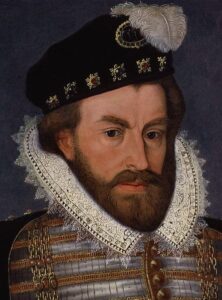
Sir Christopher Hatton, the man Elizabeth I nicknamed her “mouton” (sheep), was born in 1540. He was the son of William Hatton of Holdenby, Northamptonshire, and his wife, Alice Saunders, and was educated at St Mary Hall, Oxford.
Here is a list of offices he held, jobs he undertook and events he was involved in during the reign of Elizabeth I:-
- 1564 – Became one of Elizabeth’s gentlemen pensioners
- 1569 – Justice of the Peace, Northamptonshire
- 1571 – Member of Parliament
- 1571 – Constable of Corfe Castle
- 1571 – Clerk of council of duchy of Lancaster
- 1572 – Steward of the Manor of Wellingborough
- 1572 – Steward of Higham Ferrers and Daventry
- 1572 – Keeper of Eltham park, Kent and of Horne park, Surrey
- 1579 – Justice of the Peace for Dorset, Kent, Leicestershire, Middlesex, Warwickshire
- 1572 – Captain of the Queen’s bodyguard
- 1572 – Appointed to the conference with the Lords in May 1572 on ‘the great matter touching the Queen of Scots’
- 1576 Parliament – Appointed to committees concerning the subsidy, ports, the coinage, reciprocal treatment of foreigners, letters patent, fraudulent conveyances made by the northern rebels, the dean and chapter of Norwich, fines and recoveries, private bills, justices of the forests, excess of apparel, the Queen’s marriage, Lord Stourton’s bill and wharves and quays
- 1576 – Appointed to examine the Puritan Peter Wentworth
- 1578 – Vice-chamberlain of the Royal Household and member of the Privy Council
- 1578 – Knighted
- 1578 – Receiver of first fruits and tenths
- 1578 – Queen’s spokesman in the House of Commons
- 1578 – Involved in prosecuting John Stubbs, the man who had his right hand cut off for writing the pamphlet “The Discovery of a Gaping Gulf whereunto England is like to be swallowed by another French Marriage, if the Lord forbig not the banns, by letting her Majesty see the sin and punishment thereof”, and his publisher, William Page.
- 1581 – Involved in trying to arrange a marriage between Elizabeth and the Duke of Alençon
- 28th November 1584 – Government spokesman, spoke on the danger of Spain for over 2 hours
- 1584 – Involved in the examination and trial of William Parry (the Parry plot
- 1584 – Mary Queen of Scots claimed that Hatton was Elizabeth’s lover
- December 1584 – Led a prayer in the House of Commons for Elizabeth’s safety after it was rumoured that he was close to Mary Queen of Scots
- 1586 – Involved in trying Anthony Babington
- 1586 – A member of the commission who found Mary Queen of Scots guilty
- 1586 – Lord Lieutenant, Northamptonshire
- 1587 – Hatton was one of those who urged William Davison to send Mary Queen of Scots’ death warrant to Fotheringhay
- March, 1587 – Made the leading speech for the government against ‘the bill and the book exhibited in the Parliament… for a further reformation of the church’
- 1587 – Made Lord Chancellor
- 1588 – Chancellor of the University of Oxford
- 1590 – High Steward, Salisbury
Sir Christopher Hatton died on the 20th November 1591 at Ely Palace in London. He had been ill for some time and Elizabeth I had visited him on the 11th November. He was given a state funeral on 16th December at the old St Paul’s Cathedral and a monument was erected at the high altar. The old St Paul’s Cathedral was destroyed in the Great Fire of London in 1666.
Sir Christopher Hatton Trivia
- Hatton was considered handsome
- He never married but had an illegitimate daughter, Elizabeth, a woman made famous by the Bleeding Heart legend – click here.
- He was a Knight of the Garter
- As well as being the Chancellor of Oxford University, he was also High Steward of Cambridge University
- Between 1564 and 1587 he was such a favourite that he saw the Queen most days and the longest he was ever away from court was one week
- Hatton opposed the French marriage
- He was involved in the examination of the Duke of Norfolk
- Hatton was debt ridden from 1575 onwards and died with debts of over £40,000
- He frequently acted as Elizabeth’s spokesman
- He was conservative in religion and was a supporter of John Whitgift, Archbishop of Canterbury
- He came to live in Ely Palace, the London residence of the Bishops of Ely, after Elizabeth forced the bishops to grant him a lease for the rent of a red rose, ten loads of hay, and ten pounds, the right to walk in thegardens whenever they chose, and to gather twenty baskets of roses every year.
- He borrowed money from the Queen for improvements to his home and was unable to pay her back.
- Elizabeth I called him her “mouton”.

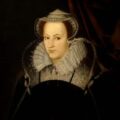
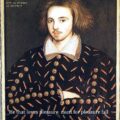
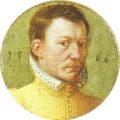
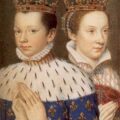
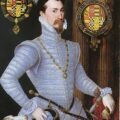
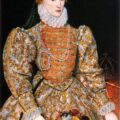
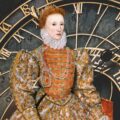
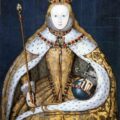
Very interesting man and seemed very accomplished as well! Also very interesting wiki article on Elizabeth Hatton (Bleeding Heart Legend) who also had an illegitimate daughter named Elizabeth with a Sir John Perrot who “allegedly” was the son of Henry VIII. Of course I doubt this very much and definitely have a hard time believing some wiki articles, but find it funny that it’s cited he was thought to be the king’s son because of his “temperament and appearance.” Seems like anyone back in those days could make such claims! 🙂
Tragically for Sir Christopher, he was in a terrible position of being compromised by Elizabeth’s promiscuity and infatuations. He was at one time her preferred amour and even though he realised she was fickle, he decided not to marry for fear of her jealousy. His self sacrifice is admirable although terribly sad. She used him dreadfully.
You can find more by checking out “The lives of the Lord Chancellors and Keepers of the Great Seal of England by Baron John Campbell Campbell” at Google Books. The following is extracted and acknowledged from this source.
The love letters between them are remarkably frank. Sir Christopher was ailing and went overseas to aid his recovery. During their separation, the lovers kept up a constant correspondence. All her letters are unfortunately lost, but the originals of many of his have lately been discovered in the State Paper Office — written in the style of an ardent and successful admirer to his mistress—his passion being rendered more romantic by distance and illness. She had given him the pastoral name of ” Lydds,” and they had agreed on certain ciphers expressing sentiments of endearment, the exact meaning of which is not disclosed to us. Here is his first, written to her only two days after their separation, showing that he had received several from her in the interval:
“If I could express my feelings of your gracious letters, I should utter unto you matter of strange effect. In reading of them, with my tears I blot them. In thinking of them I feel so great comfort, that I find cause, as God knoweth, to thank you on my knees. Death had been much more my advantage than to win health and life by so loathsome a pilgrimage. The time of two days hath drawn me further from you than ten, when I return, can lead me towards you. Madam, I find the greatest lack that ever poor wretch sustained. No death, no, not hell, no fear of death shall ever win of me my consent so far to wrong myself again as to be absent from you one day. God grant my return. I will perform this vow. I lack that I live by. The more I find this lack, the further I go from you. Shame whippeth me forward. Shame take them that counselled me to it. The life (as you will remember) is too long that loathsomely lasteth A true saying, Madam. Believe him that hath proved it. The great wisdom I find in your letters, with your Country counsels are very notable, but the last word is worth the Bible. Truth, truth, truth. Ever may it dwell in you. I will ever deserve it. My spirit and soul (I feel) agreeth with my body and life, that to serve you is a heaven, but to lack you is more than hell’s torment unto them. My heart is full of woe. Pardon (for God’s sake) my tedious writing. It doth much diminish (for the time) my great griefs. I will wash away the faults of these letters with the drops from your poor Lydds and so enclose them. Would God I were with you but for one hour. My wits are overwrought with thoughts. I find myself amazed. Bear with me, my most dear sweet Lady. Passion overcometh me. I can write no more. Love me ; for I love you. God, I beseech thee witness the same on the behalf of thy poor servant. Live for ever. . Shall I utter this familiar term (farewell)? yea, ten thousand thousand farewells. He speaketh it that most dearly loveth you. I hold you too long. Once again I crave pardon, and so bid your own poor Lidds farewell. 1573 June.
END OF EXTRACT
Even Mary Queen of Scots knew Elizabeth was free with her favours and an abuser of the loyalty she received from Sir Christopher. She wrote to Elizabeth stating: “you would never wish to lose the liberty of making love and gratifying yourself with master Hatton and another of this Kingdom” Mary continues to tell Elizabeth in no uncertain terms what she thinks of her. “[You have] compromised your honour with a foreigner named Simier going to find him at night in the chamber of a lady whom the said Countess greatly blamed in this affair, where you kissed him and indulged in divers unseemly familiarities with him. But also you revealed to him the secrets of the Kingdom betraying your own Counsellors to him.” Mary has more to say about poor Lydds. “As for the said Hatton that you ran him hard showing so publicly the love that you bore him that he himself was constrained to withdraw from it and that you gave a box on the ear to Killigrew for not having brought back the said Hatton to you after he had been sent to recall him having departed in anger from you for some insulting words you had said to him because of certain gold buttons which he had on his coat”.
Sir Christopher died a broken man unable to repay his debts, incurred in the service of Elizabeth. As he was on his deathbed Elizabeth visited him and was seen to spoon feed him with tender care and obvious affection. It didn’t help. He was too broken hearted and destitute and perhaps even felt as if Elizabeth was being disingenuous.
I write this out of respect for the memory of a great Englishman whose service to his Queen should not be underestimated.
Mike Gordon.
A bit more trivia about Sir Christopher. His sister Dorothy married William Underhill following the death of her first husband William Newport. Thier son William, Sir Chrispopher’s nephew, inherited and changed his name to Hatton.
Dorothy and William Underhill had a son also (confusingly) called William Underhill, It was William Jnr who sold New Place to Shakespeare in 1597.
Mike —
Your reference to Elizabeth’s alleged “promiscuity” is completely spurious. Elizabeth loved handsome, brilliant, accomplished men — and as a normal, passionate woman, her inability to marry (which was absolutely necessary for her to rule in her own right in that age) caused her much grief — but promiscuous? Please … you’re simply parroting slanderous allegations perpetrated by Protestant-hating Catholics (there are other kinds of Catholics, of course) and people infatuated with the myth of Mary Queen of Scots.
There’s no evidence that Elizabeth even lost her virginity (much less was promiscuous). Not only was Elizabeth examined by doctors in her late 40s to see if she could still bear children (and the evidence of loss of virginity would have been impossible to keep secret after her death, especially with the Catholic Church clamoring for anything that could impugn her character); but Robert Dudley himself, in a pique of jealousy when he returned from the Netherlands to find Elizabeth quite flirtatious with the Duc d’Anjou, shouted, “Are you still a virgin?” Robin was the only man who Elizabeth came close to yielding herself to — so no one knew better than he whether she was a virgin or not.
I can’t read the site because your Anne Boleyn tour advert can’t be closed and is sitting dead centre!
Sorry about that, on some browsers it doesn’t show a close button. Simply refresh your page. Hope that helps! x
Actually really surprised I’m related to an amazing person as Hatton.
Over many years I’ve researched Christopher Hatton and have concluded he was, indeed, a decent and caring man.I do think that his relationship with Francis Drake should be explored a bit more. I found that they knew each much more than mentioned and I believe that Francis Drake owed much of his success to Christopher Hatton.